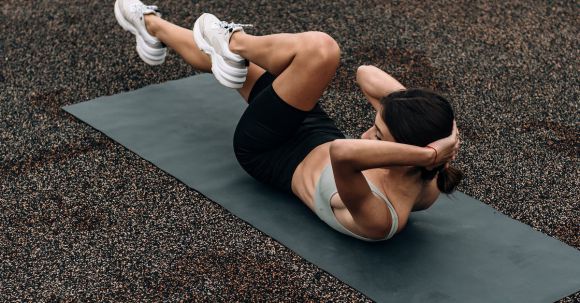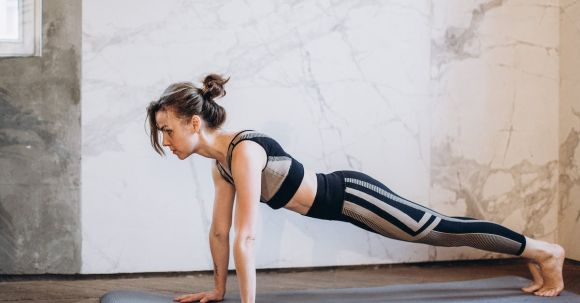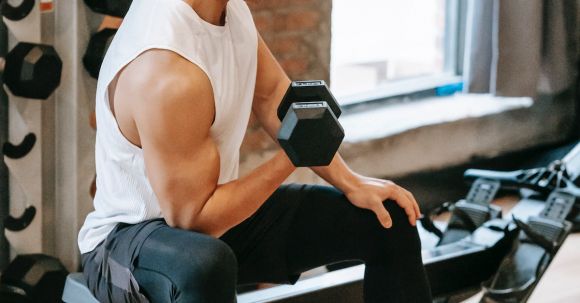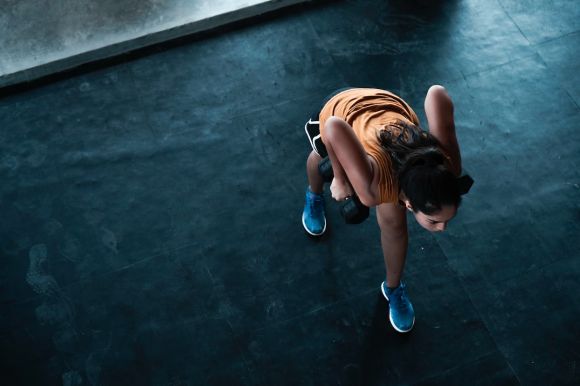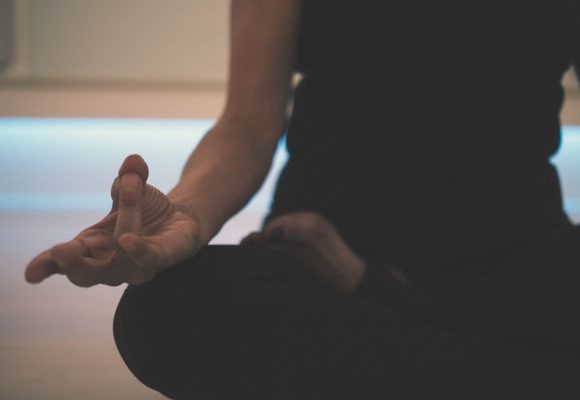Late-night snack cravings can be a major obstacle when it comes to maintaining a healthy diet and achieving weight loss goals. It's all too easy to find yourself reaching for those chips or cookies when the clock strikes midnight. However, there are strategies you can employ to conquer these cravings and stay on track with your health and fitness journey. In this article, we will explore some effective techniques to help you overcome those late-night snack temptations.
Blog Posts
Having toned abs is a goal for many people who want to improve their overall fitness and appearance. While going to the gym and using fancy equipment is one option, you can also achieve great results by doing targeted exercises right in the comfort of your own home. In this article, we will explore some effective home exercises that can help you tone your abs and achieve the physique you desire.
Plank Variations: A Solid Foundation
Planks are a fantastic exercise for strengthening your core muscles, including your abs. Start by getting into a push-up position, with your hands directly under your shoulders and your body in a straight line. Hold this position for as long as you can, aiming for at least 30 seconds. As you become more comfortable with the basic plank, you can challenge yourself by trying different variations, such as side planks or forearm planks.Crunches: Classic but Effective
Crunches are a classic ab exercise that can be done at home with no equipment required. Lie flat on your back with your knees bent and your feet flat on the floor. Place your hands behind your head, but be careful not to pull on your neck. Contract your abs and lift your upper body off the ground, aiming to bring your shoulder blades towards your knees. Lower yourself back down with control and repeat for a set number of repetitions. To make crunches more challenging, you can try different variations like bicycle crunches or reverse crunches.Mountain Climbers: Dynamic Ab Workout
Mountain climbers are a dynamic exercise that engages your abs while also providing a cardiovascular challenge. Start in a push-up position with your hands directly under your shoulders. Lift your right knee and bring it towards your chest, then quickly switch to bring your left knee towards your chest. Continue alternating your knees in a quick and controlled motion, as if you were running in place. Aim for 30 to 60 seconds of mountain climbers to really feel the burn in your abs.Russian Twists: Targeting Obliques
The obliques are the muscles on the sides of your abs, and strengthening them will help you achieve a well-rounded core. Russian twists are an effective exercise for targeting the obliques. Sit on the ground with your knees bent and your feet flat on the floor. Lean back slightly, keeping your back straight and your abs engaged. Hold a weight or a household object in front of you, and twist your torso from side to side, touching the object to the ground on each side. Aim for 10 to 15 repetitions per side.Plank Jacks: Adding a Cardio Element
Plank jacks are a challenging exercise that combines the benefits of planks with a cardio element. Start in a high plank position, with your hands directly under your shoulders and your body in a straight line. Jump your feet out wide and then quickly jump them back together, just like you would do in a jumping jack. Keep your core engaged throughout the exercise and try to maintain a steady rhythm. Aim for 30 to 60 seconds of plank jacks for a great abs workout.Conclusion: Achieving Toned Abs at Home
Toning your abs doesn't have to involve fancy equipment or expensive gym memberships. By incorporating these home exercises into your fitness routine, you can effectively target your abs and achieve the toned physique you desire. Remember to always listen to your body, start at your own fitness level, and gradually increase the intensity as you become stronger. So, why wait? Start incorporating these exercises into your home workouts and watch your abs transform.
Staying motivated while working out alone can be a challenge. Without the support and energy of a workout buddy or a group class, it's easy to lose focus and momentum. However, with the right strategies and mindset, you can stay motivated and reach your fitness goals. Here are some tips to help you stay on track when working out alone.
1. Set Clear Goals
Setting clear and specific goals is essential to staying motivated. Instead of simply saying, "I want to get in shape," be specific about what you want to achieve. Whether it's losing a certain amount of weight, running a 5k, or increasing your strength, having a clear goal in mind will give you something to work towards and keep you motivated.2. Create a Schedule
Having a consistent workout schedule is key to staying motivated. Plan out your workouts ahead of time and stick to them as much as possible. Treat your workout time as an important appointment that you can't miss. By having a set schedule, you'll be more likely to follow through and stay motivated.3. Mix Up Your Routine
Doing the same workout day after day can quickly become monotonous and lead to boredom. Keep your workouts interesting by mixing up your routine. Try different exercises, change the order of your routine, or incorporate new equipment or workout videos. By adding variety to your workouts, you'll keep things fresh and exciting, making it easier to stay motivated.4. Find What Motivates You
Discover what motivates you and use it to your advantage. Whether it's listening to energizing music, watching motivational videos, or wearing workout clothes that make you feel confident, find what gets you in the mood to exercise and incorporate it into your routine. By using these motivators consistently, you'll develop a positive association with working out and be more likely to stay motivated.5. Track Your Progress
Tracking your progress is a great way to stay motivated and see how far you've come. Whether it's measuring your weight, tracking your running distance, or recording the number of reps you can do, keeping track of your progress will give you a sense of accomplishment and motivate you to keep going.6. Reward Yourself
Rewarding yourself for reaching milestones or sticking to your workout schedule can be a great motivator. Treat yourself to a massage, a new workout outfit, or a healthy meal at your favorite restaurant. By having something to look forward to, you'll be more motivated to stay on track and reach your goals.7. Stay Positive
Maintaining a positive mindset is crucial when working out alone. Instead of focusing on what you can't do or how hard the workout is, shift your mindset to focus on what you can do and the progress you're making. Surround yourself with positive affirmations, motivational quotes, and supportive people who will encourage you on your fitness journey.8. Find an Online Community
In today's digital age, there are countless online communities and social media platforms dedicated to fitness and health. Joining an online community of like-minded individuals can provide you with support, accountability, and motivation. Share your progress, seek advice, and connect with others who are on a similar fitness journey. In conclusion, staying motivated when working out alone requires a combination of goal-setting, consistency, variety, and a positive mindset. By implementing these tips into your routine, you'll be able to stay motivated, reach your fitness goals, and enjoy the benefits of a healthy and active lifestyle. Remember, you are capable of achieving anything you set your mind to, so stay focused, stay motivated, and keep pushing forward.
In today's fast-paced and stressful world, it's no wonder that anxiety has become a common problem for many people. The constant demands and pressures of modern life can easily lead to feelings of overwhelm and unease. However, there is a simple practice that can help you overcome anxiety and find a sense of calm - meditation.
Understanding Anxiety
Before we delve into how meditation can help with anxiety, it's important to understand what anxiety is. Anxiety is a natural response to stress, but when it becomes chronic and excessive, it can interfere with our daily lives. Symptoms of anxiety may include restlessness, irritability, difficulty concentrating, and a constant sense of worry or impending doom. If left unmanaged, anxiety can negatively impact our physical and mental health.The Benefits of Meditation for Anxiety
Meditation has been practiced for thousands of years and has been proven to have numerous benefits for our overall well-being. When it comes to anxiety, meditation can be particularly effective in reducing stress levels and promoting a sense of calm. Here are some of the ways meditation can help: 1. Calming the Mind: Meditation allows us to observe our thoughts without judgment or attachment. By practicing mindfulness, we can develop a greater awareness of our thought patterns and learn to let go of negative or anxious thoughts. 2. Relaxing the Body: Anxiety often manifests in physical symptoms such as muscle tension, increased heart rate, and shallow breathing. Through meditation, we can learn to relax our bodies and activate the relaxation response, which counteracts the stress response. 3. Cultivating Gratitude and Positivity: Anxiety tends to make us focus on what could go wrong or what we lack. Meditation can help shift our mindset towards gratitude and positivity, allowing us to appreciate the present moment and cultivate a more optimistic outlook.Getting Started with Meditation
Now that we understand the benefits of meditation, let's explore how to get started. Here are some steps to help you begin your meditation practice: 1. Find a Quiet Space: Choose a quiet and comfortable space where you won't be easily distracted. It could be a corner in your home or even a park where you can sit in peace. 2. Sit Comfortably: Find a comfortable sitting position, either on a cushion or a chair. Make sure your back is straight but relaxed, and your hands are resting comfortably in your lap. 3. Focus on Your Breath: Close your eyes and bring your attention to your breath. Notice the sensation of the breath entering and leaving your body. If your mind wanders, gently bring it back to the breath. 4. Be Present: Allow yourself to fully experience the present moment. Notice any physical sensations, thoughts, or emotions that arise, but don't get attached to them. Simply observe and let go. 5. Start Small: Begin with just a few minutes of meditation each day and gradually increase the duration as you become more comfortable. Consistency is key, so aim for a daily practice.Finding Calm through Meditation
As you continue to practice meditation, you'll start to notice a shift in your overall sense of well-being. The more you cultivate mindfulness and relaxation, the more you'll be able to overcome anxiety and find calm in your daily life. Remember, meditation is a skill that takes time and patience to develop, so be kind to yourself throughout the process. In conclusion, meditation offers a powerful tool for overcoming anxiety and finding inner peace. By calming the mind, relaxing the body, and cultivating gratitude, meditation can help us navigate the challenges of life with greater ease and resilience. So why not give it a try? Start by carving out a few minutes each day to sit in stillness and watch as anxiety slowly fades away, replaced by a deep sense of calm.
Weight loss is a universal goal that many people strive to achieve. With so many weight loss programs available, it can be overwhelming to determine which one is the right fit for you. This article will explore the different types of weight loss programs, their benefits, and how to find the one that suits your needs.
Understanding Different Types of Weight Loss Programs
There is no shortage of weight loss programs on the market, each with its own unique approach. Some focus on calorie counting and portion control, while others emphasize exercise and physical activity. It's important to understand the different types of programs available to find the one that aligns with your goals and preferences.1. Calorie Counting and Portion Control
One popular approach to weight loss is calorie counting and portion control. These programs typically involve tracking your daily caloric intake and ensuring that you're consuming fewer calories than you burn. This method can be effective for those who are disciplined and enjoy keeping track of their food intake.2. Meal Replacement Programs
Meal replacement programs provide pre-packaged meals that replace one or more of your daily meals. These meals are often low in calories and designed to provide balanced nutrition. This option can be convenient for individuals who are busy and prefer not to cook or prepare their own meals.3. Exercise and Fitness Programs
For those who enjoy physical activity, exercise and fitness programs may be the right fit. These programs often include a combination of cardiovascular exercises, strength training, and flexibility exercises. Regular physical activity can help burn calories, build muscle, and improve overall health.Benefits of Weight Loss Programs
Weight loss programs offer several benefits beyond just shedding pounds. Here are some advantages to consider when exploring different programs:1. Structure and Support
Many weight loss programs provide structure and support to help individuals stay on track. This can include access to nutritionists, fitness trainers, or online communities where you can connect with others on a weight loss journey. Having a support system can be incredibly motivating and make the process feel less daunting.2. Education and Accountability
Weight loss programs often provide educational resources to help you understand the science behind weight loss and healthy habits. They can also hold you accountable by tracking progress and setting realistic goals. This combination of education and accountability can increase your chances of long-term success.Finding the Right Program for You
With so many weight loss programs to choose from, finding the right one can feel like a daunting task. Here are some tips to help you narrow down your options:1. Consider Your Goals and Preferences
Think about what you hope to achieve from a weight loss program and what type of approach resonates with you. If you enjoy cooking and preparing your own meals, a program that focuses on portion control and calorie counting may be a good fit. If convenience is important to you, a meal replacement program could be the way to go.2. Research and Read Reviews
Before committing to a weight loss program, do your research and read reviews from others who have tried it. Look for programs with positive feedback and success stories that align with your goals. This can give you a better idea of whether a program is worth investing your time and money in.3. Consult with a Healthcare Professional
If you're unsure about which weight loss program is right for you, consider consulting with a healthcare professional. They can help assess your individual needs, provide personalized recommendations, and ensure that any program you choose is safe and suitable for your health.Conclusion: Finding the Right Fit
When it comes to weight loss programs, there is no one-size-fits-all solution. It's important to explore the different options available and find the program that aligns with your goals, preferences, and lifestyle. Remember to consider the benefits of each program, and take the time to research and consult with professionals if needed. With the right fit, you can embark on a successful weight loss journey and achieve the results you desire.
In today's fast-paced world, finding time to fit in a workout can be a challenge. Between work, family, and other responsibilities, it's easy to let physical fitness take a back seat. However, with the right mindset and a few simple adjustments, you can improve your overall fitness right in the comfort of your own home. Here are some effective tips to get you started.
Create a Dedicated Space
The first step to improving your overall fitness at home is to create a dedicated space for your workouts. Whether it's a spare room, a corner in your living room, or even just a mat in the corner of your bedroom, having a designated area will help you stay focused and motivated. Clear out any clutter and make sure you have enough room to move around comfortably.Set Realistic Goals
Before you begin your home fitness journey, it's important to set realistic goals. Whether you want to lose weight, gain muscle, or simply improve your overall health, having a clear vision of what you want to achieve will help you stay motivated and on track. Start small and gradually increase the intensity and duration of your workouts as you progress.Find a Workout Routine that Works for You
With the plethora of online fitness resources available, finding a workout routine that suits your needs and preferences has never been easier. From high-intensity interval training (HIIT) to yoga and everything in between, there is something for everyone. Experiment with different styles and find what you enjoy the most. This will not only make your workouts more enjoyable but also increase the likelihood of sticking to your routine.Make Use of Bodyweight Exercises
One of the great advantages of working out at home is that you don't need fancy equipment to get in shape. Bodyweight exercises, such as push-ups, squats, lunges, and planks, can be incredibly effective in building strength and improving overall fitness. They require little to no equipment and can be modified to suit your fitness level. Incorporate these exercises into your routine to target different muscle groups and achieve a well-rounded workout.Utilize Household Items
If you don't have access to weights or resistance bands, don't worry! You can still get a challenging workout using household items. Fill up water bottles or backpacks with books to create makeshift weights for strength training exercises. Use a chair for tricep dips or step-ups. Get creative and think outside the box – you'll be surprised at how many everyday items can double as exercise equipment.Stay Consistent and Accountable
Consistency is key when it comes to improving your overall fitness. Set a schedule and stick to it. Treat your workouts as non-negotiable appointments with yourself. Additionally, find ways to hold yourself accountable. This could be by tracking your progress, joining an online fitness community, or finding a workout buddy to keep you motivated.Stay Hydrated and Fuel Your Body Properly
Proper hydration and nutrition are essential for overall fitness. Make sure to drink plenty of water before, during, and after your workouts to stay hydrated. Fuel your body with a balanced diet that includes lean proteins, whole grains, fruits, and vegetables. Avoid processed foods and sugary drinks that can hinder your progress.In Conclusion
Improving your overall fitness at home is not only convenient but also achievable with the right approach. Create a dedicated space, set realistic goals, find a workout routine that works for you, and make use of bodyweight exercises and household items. Stay consistent, hold yourself accountable, and prioritize proper hydration and nutrition. By following these tips, you'll be well on your way to a healthier, fitter you.
Are you looking to strengthen your core and get those toned abs you've always wanted? Look no further than the Fit on 30-day Ab Challenge! This challenge is designed to target your abdominal muscles and help you achieve a stronger core in just one month. In this article, we will take a closer look at the benefits of this challenge and provide you with a step-by-step guide to get started.
Why Focus on Core Strength?
A strong core is essential for overall physical fitness. Not only does it improve your posture and stability, but it also plays a crucial role in everyday movements such as bending, twisting, and lifting. Additionally, a strong core can help alleviate back pain and reduce the risk of injury during physical activities. By participating in the Fit on 30-day Ab Challenge, you can give your core the attention it deserves and reap the benefits of a stronger, more stable body.The Fit on 30-day Ab Challenge: How It Works
The Fit on 30-day Ab Challenge is a structured program that gradually increases in intensity over the course of 30 days. Each day, you will be given a set of exercises targeting your abdominal muscles. These exercises are carefully chosen to engage all areas of your core and ensure a comprehensive workout. The challenge starts with beginner-friendly exercises and gradually progresses to more advanced movements as your core strength improves.Getting Started: Day 1
On the first day of the challenge, you will be introduced to a series of basic ab exercises. These exercises include planks, sit-ups, and leg raises. The goal is to perform each exercise for the designated number of repetitions or time. Remember to maintain proper form throughout the movements and listen to your body. If an exercise feels too challenging, modify it to suit your fitness level.Progressing Through the Challenge
As the challenge progresses, the exercises become more challenging to keep pushing your core strength to new heights. You may find yourself incorporating side planks, Russian twists, and bicycle crunches into your routine. The increasing intensity ensures that your core muscles are constantly challenged and stimulated for maximum growth and development.Staying Motivated
To stay motivated throughout the 30-day Ab Challenge, it is important to set realistic goals and track your progress. Keep a journal to record your daily workouts, noting any improvements in strength or endurance. Celebrate your achievements along the way, whether it's being able to hold a plank for an extra 10 seconds or completing a set of advanced exercises without modifications. Remember that consistency is key, so make sure to stick to the challenge schedule and complete each day's workout.Conclusion: A Stronger Core Awaits
If you're ready to take your core strength to the next level, the Fit on 30-day Ab Challenge is the perfect program for you. By dedicating just a few minutes each day to these targeted exercises, you can achieve a stronger core and have those coveted toned abs. Remember to listen to your body, modify exercises as needed, and track your progress along the way. Get started today and watch as your core transforms in just 30 days!
Are you tired of hitting a plateau in your fitness journey? Do you feel like you've reached a stagnant point and can't seem to make any progress? Don't worry, you're not alone. Plateaus are a common challenge that many people face when it comes to achieving their fitness goals. Fortunately, with the rise of online personal training, there are now effective ways to overcome plateaus and continue making progress towards your goals.
Understanding Plateaus
Before we dive into how online personal training can help you overcome plateaus, it's important to understand what exactly a plateau is. A plateau occurs when your body adapts to the current level of exercise you're doing, and as a result, you stop seeing progress. This can be incredibly frustrating, as you may feel like you're putting in the effort but not getting the desired results.The Role of Online Personal Training
Online personal training has become increasingly popular in recent years, and for good reason. It offers a convenient and flexible way to receive personalized fitness guidance from qualified trainers, all from the comfort of your own home. When it comes to overcoming plateaus, online personal training can be a game-changer.Customized Workout Plans
One of the main advantages of online personal training is the ability to receive customized workout plans. Unlike generic workout programs, personalized plans take into account your specific goals, fitness level, and any limitations or injuries you may have. A qualified online personal trainer can create a plan that challenges your body in new ways, helping you break through plateaus and continue making progress.Variety and Progression
Plateaus often occur when your body becomes too accustomed to a specific workout routine. Online personal training can help you overcome this by introducing variety and progression into your workouts. Your trainer can continually update and modify your plan, incorporating new exercises, changing the intensity, and challenging different muscle groups. This keeps your body guessing and prevents it from adapting, allowing you to push past plateaus and reach new levels of fitness.Accountability and Support
Another key factor in overcoming plateaus is accountability and support. Online personal training provides a support system that can help you stay motivated and on track. Your trainer will be there to check in on your progress, answer any questions, and provide the necessary guidance and encouragement. This level of accountability can be a powerful tool in helping you overcome plateaus and stay committed to your fitness journey.Tracking and Monitoring
Tracking and monitoring your progress is essential when it comes to overcoming plateaus. Online personal training platforms often include tools and features that allow you to track your workouts, monitor your progress, and assess your results. This data can help you and your trainer identify patterns, make necessary adjustments, and ensure that you're continually moving forward. In conclusion, plateaus are a common challenge in any fitness journey, but they don't have to be a roadblock. With the help of online personal training, you can overcome plateaus and continue making progress towards your goals. By receiving customized workout plans, introducing variety and progression, benefiting from accountability and support, and utilizing tracking and monitoring tools, you can break through plateaus and reach new heights in your fitness journey. So why wait? Start exploring the world of online personal training and take your fitness to the next level today.
Yoga is a powerful practice that not only strengthens and stretches the body but also has the ability to detoxify both the physical body and the mind. One of the most effective yoga postures for detoxification is the twist. Twisting poses are not only beneficial in increasing flexibility and mobility, but they also help in releasing toxins, improving digestion, and calming the mind. In this article, we will explore how yoga twists can detoxify your body and mind, and how to incorporate them into your practice.
Benefits of Yoga Twists
1. Stimulate Digestion: Twisting poses compress the digestive organs, which helps in stimulating digestion and improving overall gut health. When the organs are compressed, fresh blood flows into them, bringing oxygen and nutrients, and flushing out toxins and waste products. This increased blood flow helps in improving digestion and relieving symptoms of bloating and constipation. 2. Detoxify the Body: Twisting poses wring out the internal organs, which helps in detoxifying the body. As you twist, the organs are compressed, and when you release the twist, fresh blood flows into them, carrying away toxins and waste products. This process helps in improving the functioning of the organs and enhances the body's natural detoxification process. 3. Increase Spinal Mobility: Twisting poses improve spinal mobility and flexibility. As you twist, you lengthen and rotate the spine, which helps in releasing tension and tightness in the back muscles. A flexible spine is essential for overall health and vitality, as it allows for better circulation and nerve function. 4. Calm the Mind: Twisting poses not only detoxify the body but also have a calming effect on the mind. As you twist, you are required to stay present and focus on the breath. This mindful awareness helps in quieting the mind and reducing stress and anxiety. Twists also help in releasing tension stored in the body, which further promotes a sense of relaxation and calmness.Incorporating Yoga Twists into Your Practice
1. Seated Twist (Ardha Matsyendrasana): Sit on the floor with your legs extended in front of you. Bend your right knee and place your right foot on the outside of your left knee. Inhale and lengthen your spine, then exhale and twist towards the right, placing your left elbow on the outside of your right knee. Stay in the pose for a few breaths, then repeat on the other side. 2. Revolved Triangle (Parivrtta Trikonasana): Start in a standing position, with your feet hip-width apart. Step your left foot back about 3-4 feet and rotate it slightly to the left. Inhale and lift your arms to shoulder height, then exhale and hinge forward from the hips, placing your right hand on the outside of your left foot. Extend your left arm towards the ceiling, and gaze up towards your left hand. Stay in the pose for a few breaths, then repeat on the other side. 3. Supine Twist (Supta Matsyendrasana): Lie on your back with your knees bent and your feet on the floor. Extend your arms out to the sides at shoulder height. Inhale and lengthen your spine, then exhale and drop both knees to the right, twisting your spine. Keep both shoulders grounded on the floor. Stay in the pose for a few breaths, then repeat on the other side. Conclusion: Yoga twists are a valuable tool for detoxifying the body and mind. By incorporating twisting poses into your regular yoga practice, you can stimulate digestion, release toxins, increase spinal mobility, and calm the mind. Remember to listen to your body and practice with awareness and intention. With regular practice, you will experience the transformative power of yoga twists and enjoy the benefits of a detoxified body and a peaceful mind.
Grocery shopping is a task that most people have to do on a regular basis. Whether you love it or hate it, there's no denying the importance of being able to shop efficiently and effectively. In this article, we will explore some tips and tricks to help you grocery shop like a pro.

